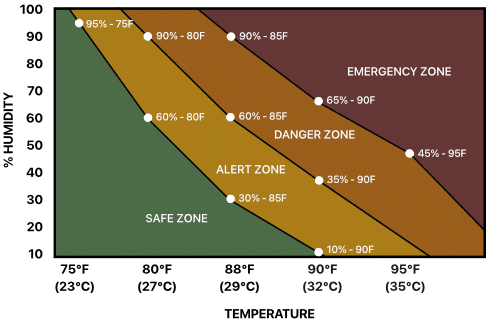
Exercise and Weather
Exercise in Hot Weather
High heat and humidity causes higher heart rates and blood pressures during exercise. Heat and humidity may also cause shortness of breath even with normal activity. You may also feel irregular heartbeats (palpitations), light-headed, or dizzy.
Hot days also increase the smog and pollution in the air. Smog and pollution may also cause irregular heartbeats, light-headedness, or dizziness. See the Heat Safety Index and Air Quality Health Index to see if it is safe for outdoor exercise.
Follow these exercise safety tips when the weather is hot:
The Heat Safety Index can help you decide if it is safe to exercise and go outdoors. This index uses temperature and percentage of humidity (how much water is in the air) to create four safety zones: safe, alert, danger and emergency.
To use the Heat Safety Index:
- Find the current local temperature along the bottom of the scale.
- Find the current percentage of humidity along the left hand border of the scale.
- Find the point on the graph where these two points come together. See what safety zone this point is found in.
- Follow the instructions in the ‘what you do for each heat safety zone’ chart.

- Safety Zone
- Exercise as usual
- Safe to exercise outdoors
- Alert Zone
- Decrease your exercise intensity (slow your walking pace)
- Watch for signs (such as shortness of breath, increased tiredness)
- Danger Zone
- No outdoor exercise
- Exercise in an air conditioned environment only
- Emergency Zone
- Avoid going outdoors
Check the air quality before you exercise outdoors to know how much air pollution there is. Air pollution happens when many pollutants (substances that are harmful to your health) are in the air. Air pollution is a health concern for all people. It is an even greater concern for people living with heart or lung disease, older people and younger children.
When you check the weather report for air quality, look for the Air Quality Health Index (AQHI). This index tells you the level of common air pollutants.
In Ontario, the range for the index is 0 to 10. The lower the number, the better the air quality. If you live outside of Ontario, go to your local public health website to find out how your area lists the air quality index. Follow the instructions in the ‘what you do for each air quality category’ chart.
| AQHI Number | Risk Level | What to Do |
|---|---|---|
| 1, 2, and 3 | Low Risk | Exercise as usual Safe to exercise outdoors |
| 4, 5, and 6 | Moderate Risk | Decrease your exercise intensity Watch for signs Consider rescheduling your outdoor exercise |
| 7, 8, 9, and 10 | High Risk | No outdoor exercise Exercise in an air conditioned environment only |
| Above 10 | Very High Risk | Avoid going outdoors |
Drink water before, during, and after your exercise. Dehydration (loss of body fluids) can lead to higher heart rates, shortness of breath, and feeling dizzy.
If you exercise for up to 1 hour, follow the guidelines below:
- Drink 6-8 ounces of water (about 175 to 240mL) before you exercise.
- Drink 6-8 ounces of water (about 175 to 240mL) every 20 minutes during exercise and after you cool down.
- Do not wait to drink water until you feel thirsty.
Speak to your doctor if you have limits on how much fluid you can have each day.
Follow these tips to dress for hot weather:
- Choose light coloured, loose, comfortable clothing to help reflect the sun and allow air flow to help you stay cool.
- Choose a fabric that helps sweat move away from your body. Dry wick (synthetic, man-made) fabrics work best.
- Wear a hat or visor.
- Use sunscreen to protect your skin.
If you are traveling, give yourself about a week to adjust to the new temperature.
Your blood sugar changes based on the weather and each person responds differently.
Your blood sugar levels can lower in hot weather for 2 main reasons:
- The blood vessels in your skin open wider to keep you cooler.
- Insulin acts quicker during warm weather.
Your blood sugar can also be higher in hot weather for 2 main reasons:
- You are dehydrated (loss of body fluids).
- Your body is under stress, such as dealing with the heat and humidity.
Be aware and check your blood sugar more often in hot weather.
Some diabetes medicines make you more likely to become dehydrated and sunburnt. Talk to your doctor or pharmacist about your medicines.
Exercise in Cold Weather
Safety Alert
Do not exercise outdoors if the temperature with wind chill is below -10°C.
Cold weather can make your exercise feel tougher.
Cold weather makes your arteries tighten. When your arteries tighten, it is harder for blood to get through to deliver oxygen to your heart and exercising muscles.
Cold weather also causes your heart rate and blood pressure to rise. High heart rates and blood pressures make your heart work too hard and put you at risk for heart problems.
If you prefer to exercise outdoors, even when it’s cold, follow the safety tips below:
- Do not exercise outdoors if the temperature with wind chill is below -10°C. Your body will have to work too hard with colder temperatures.
- Wear layers of clothing and a hat to help keep warm. Remove a layer of clothing if you get too warm. Staying warm will make exercise feel more comfortable. It also keeps your arteries wider to let blood flow to your heart and muscles.
- The layer of clothing next to your skin should be moisture wicking “dry-fit” material. Clothing material such as polyester or a ribbed shirt with a wool/cotton blend. You will be too cold if the layer on your skin gets wet from your sweat.
- Cover your mouth and nose with a scarf. The scarf helps warm the air you breathe and keeps you warmer.
- Wear your running shoes outdoors. Your running shoes have the best traction and are lightweight.
- Keep hydrated (drink plenty of water), even during the winter.
- Keep your glucometer and insulin at the recommended temperature (check the drug label). They will not work if they have been frozen. Insulin that has not been opened can be kept in the fridge.
- Slow down if it is windy or icy. A slower pace prevents falls.
- Choose an exercise route clear of snow and ice to avoid falls.